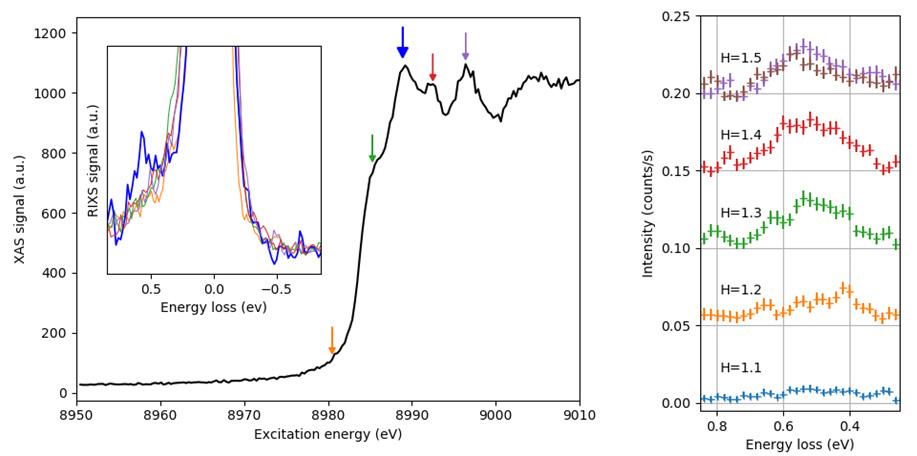The measurement of elementary excitations in a material requires high resolution spectroscopic probes with momentum resolution. RIXS is a powerful technique to characterize these low energy excitations. On GALAXIES beamline, a new High Resolution RIXS setup is available to users for investigating complex materials.
Material properties are fundamentally controlled by the behavior of low energy electrons. The knowledge of this electronic ground state is a primary, yet insufficient, ingredient to understand the physical properties. To characterize the full response of the material to external perturbation, it is equally essential to understand the elementary excitations, whose energy and dispersion in the momentum space will affect the overall material behavior. Clearly, the measurement of these excitations requires high resolution spectroscopic probes with momentum resolution. Resonant inelastic x-ray scattering (RIXS) has emerged as a powerful technique to characterize these low energy excitations. This technique complements traditional inelastic neutron scattering because it is element selective, is available for small samples, and can be performed in challenging sample environments. The GALAXIES team has recently succeeded in measuring their beamline’s first high resolution RIXS results, offering users a new tool for investigating complex materials.
The setup is illustrated in Figure 1. The scattered x-rays are collected by a 100 mm diameter ‘diced’ crystal analyzer. The analyzer is an array of mm-size crystalline cubes arranged on a spherical substrate. The role of the analyzer is to filter the scattered x-rays (by Bragg diffraction) and focus them onto a 2D detector. The unstrained single crystal quality of the analyzer ensures very high resolution. In addition, each cube acts as a dispersive element, providing extra resolving power. By scanning the analyzer Bragg and post-processing the detector images, it is possible to reconstruct high resolution RIXS spectra as shown in Figure 2.
.

Figure 1: Schematic of the high resolution RIXS setup. The scattered x-ray beam is reflected by a 100 mm diameter spherically bent ‘diced’ crystal analyzer. The analyzer filters, disperses and focuses the x-ray photons on to a 2D pixelated detector

Figure 2: (left) Image of an elastic peak on the 2D detector at a given Bragg angle. (center) When scanning the Bragg angle, the elastic line moves on the detector (right) The correct spectrum can be reconstructed from the energy dispersion and pixel-energy correlation. A Gaussian fit provides a FWHM of 115 meV.
The method has recently been applied to investigate the low energy magnetic excitations in the high temperature superconducting (HTS) cuprate parent compound, Ca2CuO2Cl2. Magnetic excitations have been intensively studied for their possible role in the pairing mechanism in HTS cuprates. However, the interpretation of the experiments remains highly controversial because of the lack of theoretical understanding of electronic correlations in realistic systems. The cuprate family Ca2CuO2Cl2 offers a unique opportunity to bridge state-of-the-art theory and experiment, due to its reduced number of electrons and relatively simple structure. However, since it is only available as small single crystals, it was infeasible to study the material with inelastic neutron scattering and it is just becoming possible to study it with RIXS due to advances in high resolution instrumentation.

Figure 3: (left) RIXS spectra at different incident energies shows a resonance at 8989 eV. (right) High resolution RIXS spectra in Ca2CuO2Cl2 at the Cu K-edge after subtracting elastic peak taken at different positions in reciprocal space (H, 0, 14). Spectra are offset by 0.05 counts/s for clarity and two different measurements are shown for H=1.5.
The measurements were performed at the Cu K-edge using a Ge(733) diced analyzer from APS at a Bragg angle of ~88° and a MERLIN 2D detector. The overall resolution was 115 meV at 8980 eV as estimated from the FWHM of the elastic line, yielding a resolving power of ~80000. Despite an intense elastic line, a clear excitation can be seen around 540 meV which resonates in the near edge region at 8989 eV (Figure 3). The excitation – interpreted here as primarily a bimagnon – decreases in intensity towards low momentum transfer as expected by theory. However, the expected dispersion is not clearly seen and there is a complex multi-magnon structure. Future experiments on Ca2CuO2Cl2 in both the undoped and doped regimes will be coupled with quantum Monte Carlo calculations which will help us shed light on the complex structure of these magnetic excitations in the cuprates and elucidate their possible role in Cooper pairing.
The bimagnon measured was incredibly weak, only about 2 photons/min/channel with an incident flux of 6 x 1012 photons/min. Future experiments will benefit greatly from the GALAXIES newly installed high resolution monochromator which will be commissioned soon.
